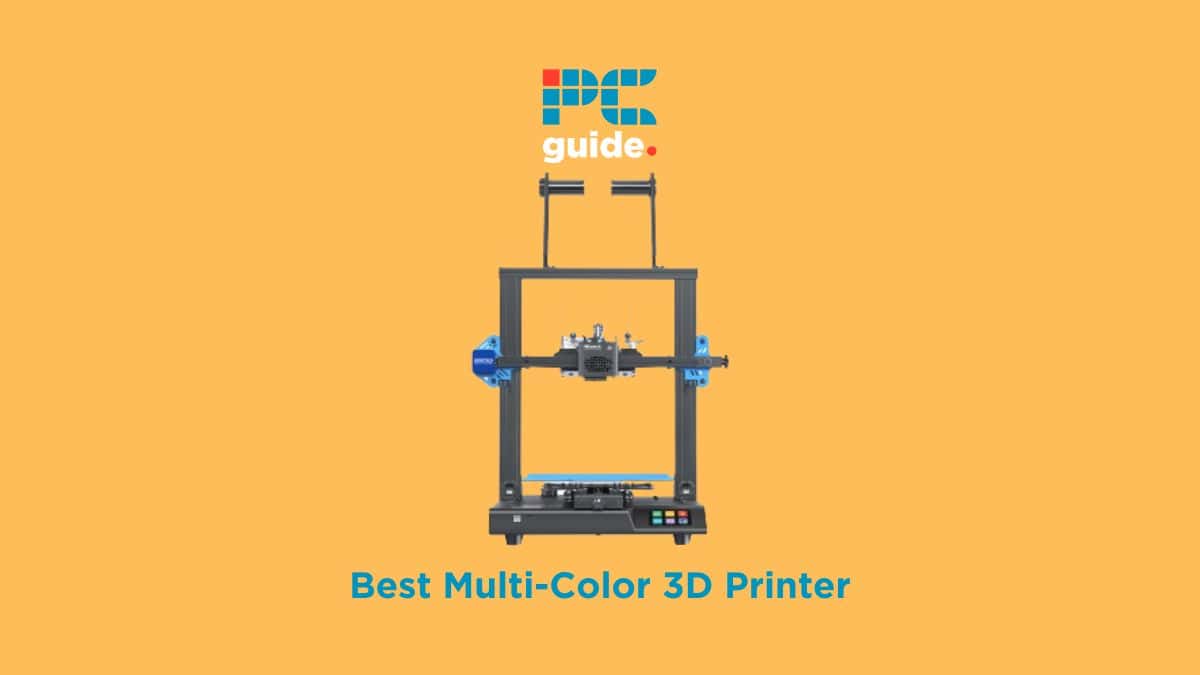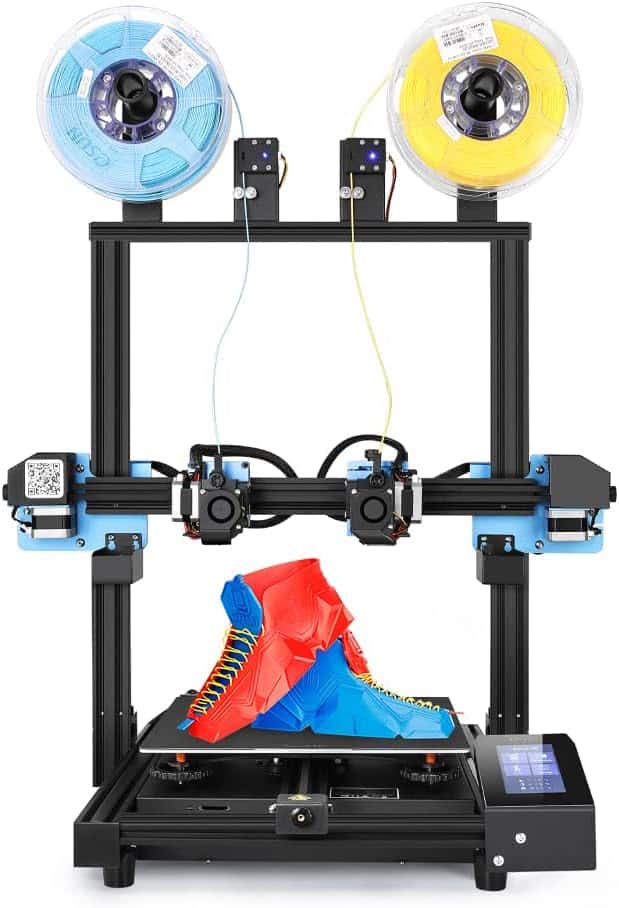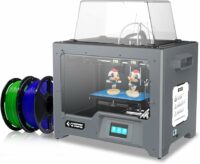Best Multi Color 3D Printer – Our Top Picks for Multiple Colors

Table of Contents
Multi-color printing on 3D printers isn't nearly as straightforward as more traditional 2D printing for graphic design, as 3D printers have to adapt and recolor the filaments used as they go. The best multi color 3D printers use multiple extruders at once to mix multiple colors of filament simultaneously. There are a range of options for 3D printers, and though looking specifically for multi-color versions helps narrow the search, it can still be challenging.
That's where we come in: we've put together a list of the best 3D printers for any budget or application. Whether you're a 3D-printing veteran looking for something more versatile, or a novice looking to create some colorful creative work, we'll help you find the best multi-color 3D printer for you!
-
Best Multi Color 3D Printer
Geeetech Mizar M
- Build Volume: 255mm x 255mm x 260mm
- Filament: PLA, ABS, PETG
- Connectivity Technology: SD
- Filetype: STL, GCode
-
Best Large Volume Multi Color 3D Printer
Sovol SV04
- Build Volume: 300mm x 300mm x 400 mm
- Filament: PLA, ABS, PETG, PC, PVA, Wood
- Connectivity Technology: MicroUSB
- Filetype: STL, OBJ
-
Best Budget Multi Color 3D Printer
Creality 3D Mini FDM 3D Printer Ender 2 Pro
-
Best Enclosed Multi Color 3D Printer
FlashForge Creator Pro 2
- Build Volume: 300mm x 300mm x 325mm
- Filament: PLA, ABS, PETG, HIPS
- Connectivity Technology: USB
- Filetype: STL
-
Best Mid-Range Multi Color 3D Printer
Geeetech A20M
- Build Volume: 255mm × 255mm × 255mm
- Filament: PLA, ABS, PETG, Wood, PVA, HIPS
- Connectivity Technology: USB, TF Card
- Filetype: STL, GCode
How We Picked the Best Multi Color 3D Printer
When looking for the best 3D printer for multiple colors, we prioritized multi-extruder printers over other models. Known as IDEX (Independent Dual Extruder) 3D printers, two or more nozzles work in conjunction to inject multiple filament spools into the mode. These models can vary in price from under $1,000 to industrial-grade printers north of $10,000. Naturally, we leaned more toward the former: 3D printers that give you quality model rendition without breaking the bank.
We settled on five products, each with their own respective merits, that are all capable of high-quality multi-colored 3D prints, to save you having to manually paint them yourself.

- Build Volume: 255mm x 255mm x 260mm
- Filament: PLA, ABS, PETG
- Connectivity Technology: SD
- Filetype: STL, GCode
The Mizar M stands as a unique multi-color 3D printer, highlighting an impressive benchmark in varied FDM printing capabilities.
- Gradient mixing – along with standard block colors, the Mizar M can seamlessly blend prints together for a stylish 3D print.
- Intuitive design – with automated leveling and intelligent configuration options, the Mizar M is great for beginners and veterans alike.
- Smaller build volume – whilst 260mm x 260mm x 260mm shouldn’t be dismissed out of hand, it does limit the creative scope of your 3D prints.
Out of all the multi-color printers we found, our favorite was the Geeetech Mizar M, which employs mixed-color printing along with dual extruders to take 3D color profiles to the next level. Just having either dual extruder printing or mixed color printing would be enough to make a multi-color 3D printer pass our tests, but the Mizar M combines both. And the results speak for themselves…
Geeetech allows its users two multi-color printing modes with the Mizar M: “Gradient Color” and “Separated Color” modules. Separated Color mode is the typical manual filament switching that you'd find in most 3D printers with a single extruder. It's less aesthetic than gradient mode, but it's faster and is more than enough if you're only looking to print in two colors. More innovatively, Gradient Color mixes colors as they melt and prevents them from flowing back into the flow channel – in layman's terms, this means less uneven color mixing and no jarring breaks. The Mizar M also allows manual and automatic leveling, making it a good option for beginners and adepts alike: they can use their preferred option to customize their prints as they like.
Unfortunately, print sizes aren't the biggest on the Mizar M, as it's capable of producing objects only up to 26cm in dimension. A smaller nitpick, as the technology on display is superb, especially for this price point. We highly recommend the Mizar M to designers both new and experienced, and are happy to call it the best multi-color 3D printer!

- Build Volume: 300mm x 300mm x 400 mm
- Filament: PLA, ABS, PETG, PC, PVA, Wood
- Connectivity Technology: MicroUSB
- Filetype: STL, OBJ
A high-end, large-volume, multi-color 3D printer; the SV04 is one of our favorite IDEX 3D printers.
- Efficient extruders – the two extruders are able to work seamlessly thanks to their dual drives and dual z-axis controls for seamless acceleration.
- Easy to use – the SV04’s software is intuitive and quick to master, and is compatible with a range of slicers.
- Inconsistent auto leveling – the SV04’s automatic leveling is the one automated feature that doesn’t work well, and it’s a potential deal-breaker for beginners.
The Sovol SV04 must have one of the best value-to-volume ratios of any 3D printer on the market. At a reasonable price and with the latest direct-drive extruder technology, this professional 3D printer is a worthwhile addition to their design studio for great-quality color 3D printing.
The SV04 can print models up to 300mm x 300mm x 400 mm, which is plenty for most people who don't need a heavy-duty printer for commercial purposes. It uses two extruders to produce crisp and clean colors on your objects. The Direct Drive Extruders are much smaller in size, and are capable of higher precision than their regularly-sized counterparts. A less important, but welcome nonetheless, is the easy-to-use Sovol software, which is quick to understand and allows you to pause a print should you run out of filament or suffer a power issue.
However, there are some issues with the SV04. The printer's auto-leveling consistency can vary, causing unwanted wobble that can ruin the printing process. You may need to do a few practice prints to run it in, which isn't ideal for those wanting as little waste as possible. For a veteran designer wanting a larger 3D printer with more varied color options, it's hard to beat the Sovol SV04!

Compact yet capable, we’re big fans of Creality 3D printers here – and this compact multi color unit proves exactly why.
- Affordable – Creality’s commitment to low-cost 3D printers makes the Ender 2 Pro a great entry point into the world of 3D printing.
- Easy assembly – with just four steps between the printer arriving and the printer printing, this is a tremendously low-effort 3D print solution.
- Manual color switching – rather than a dual extruder option, the Ender 2 Pro must be manually switched between color options.
For an ultra-cheap entry-level 3D printer that is capable of printing in color, Creality's Ender 2 Pro is a plucky yet practical choice. Those familiar with the brand will know that Creality has some great 3D printers for beginners, and this is no exception. Aimed at novices in the 3D-printing world, the Ender 2 Pro is light on features but equally light on the wallet.
The Ender 2 Pro has a single extruder that you can use to manually switch between filament colors to create colorful objects. A four-step assembly process is all that stands between you and printing out great 3D models. The resulting quality is excellent when you consider the super-affordable price tag – a fraction of what other models on this list cost!
Of course, there is a tradeoff in build quality with any budget 3D printer, and the Ender 2 Pro is no exception. It's far from the most durable 3D printer, and the single extruder means that printing is slow going. With all-manual leveling rearing its ugly head once more, be prepared for some print issues. But overall, we're happy with the experience we got out of the Ender 2 Pro: matching our expectations without matching on price.

- Build Volume: 300mm x 300mm x 325mm
- Filament: PLA, ABS, PETG, HIPS
- Connectivity Technology: USB
- Filetype: STL
This fast and near-flawless 3D printer is great for quick and quality 3D models in a variety of filaments.
- Fast printing speeds – the dual extruders work fast and effectively to create simultaneous or blended designs.
- Easy to use – the Creator Pro 2 is intuitive and easy to use, even for beginners.
- Loud – the Creator Pro 2 emits a lot of noise, which can make monitoring your prints a literally painful task.
A runner-up for the coveted title of “best multi-color 3D printer”, we were big fans of the Creator Pro 2 from FlashForge. With easy assembly and a great design, this 3D print has a few pitfalls that hamper an otherwise great print solution.
For a 3D printer in this price range, the Creator Pro 2 is quite sturdy and firm, and you can feel that during assembly. On the topic of assembly, it comes with clear and straightforward instructions, though some beginners may need to take their time if they've never assembled a 3D printer before. An IDEX printer, the dual extruders work separately but simultaneously and with a variety of filaments, allowing for great color variety and complex designs. Whilst the Creator Pro 2 is manual-leveling only, it does provide some greatly-appreciated leveling assistance.
So what made us choose the Mizar M over the Creator Pro 2? Our biggest issue with this 3D printer is the noise level: whilst not deafening, spending protracted amounts of time with this printer is a headache – even though it's an enclosed 3D printer. Due to this format, print volume is also slightly less than other contemporaries, at 200mm x 148mm x 150 mm. These disappointments do bar the Creator Pro 2 from our top spot, but it's still a capable IDEX printer and comes highly recommended!

- Build Volume: 255mm × 255mm × 255mm
- Filament: PLA, ABS, PETG, Wood, PVA, HIPS
- Connectivity Technology: USB, TF Card
- Filetype: STL, GCode
Affordable yet capable, we’re big fans of this runner-up 3D printer, also from Giantarm.
- Mid-Range Printing – though not the best on the market, the A20M boasts a range of mid-range features as a great median between quality and price.
- Gradient printing – like the Mizar M, this Geeetech printer can print in blended shades for stylish results.
- Manual leveling only – not suitable for beginners, the manual bed leveling is a frustrating lacking feature in this 3D printer.
For a multi-color 3D printer solution under $1000 that employs technology reserved for much higher prices, consider our final pick: the Geeetech A20M. This 3D printer incorporates similar gradient technology to the Mizar M, allowing for tremendous results in either single blended prints or simultaneous printing.
The A20M accommodates a 255mm x 255mm x 255mm build volume, allowing designers to experiment with a moderate space. Another Geeetech 3D printer, the A20M comes packed with useful features such as easy extruder wiring and power outage detection; and comes mostly pre-assembled for quick setup. Boasting compatibility for a number of popular filaments such as ABS, the A20M is a versatile print option for those wanting to experiment with multiple materials as well as multiple colors.
You may want to consider cutting your teeth on a more accessible printer if you're a beginner however: with exclusively manual leveling, the A20M is a difficult 3D printer to get started with. It's an ideal mid-range option, however, and worth its low cost to those willing to pay it!
Features and Considerations
Regardless of which 3D printer you choose, here are some things to check before you buy any multi-color 3D printer:
Build Volume
Like a standard printer's print size, a 3D printer will have a maximum build volume – normally measured in millimeters. Some 3D printers have open-frame designs that enable you to cleverly bypass the build volume limit, or you can print your design in components and assemble them externally. Regardless, ensure that your 3D printer has a suitable volume for what you plan to make with your unit.
Print Speed
3D printing is a slow process at the best of times, but some units run faster than others – generally measured in millimeters per second (mm/s), with acceleration determining how quickly the 3D printer can reach those speeds when changing direction. Dual extruder 3D printers tend to be the fastest.
Bed Adhesion
3D printers place the design onto what's known as a “bed” whilst printing, which provides a base for the model. These come in a variety of shapes and forms, some being removable or flexible for easy removal of models. Depending on what you intend to print, make sure that your filament sticks well to the bed for the best quality in the finished product – removable plates are also generally the most convenient, especially for dual-extruder printers creating several products at once.
Filament
There are a wide range of different filaments available for 3D printers. From standard PLA to more specialist options like Nylon. Equally important, however, is the color of the choice of filament. Some materials are only available from certain manufacturers in certain shades, which can cause mismatching texture if blended. Consider the end-result you want to have, and the filament you have at your disposal – as not all 3D printers are compatible with all filaments.
Are Multi-Color 3D Printers Worth It?
In our opinion: yes. 3D printers are already incredibly versatile machines, with plenty of customization options and methods by which to create stunning realizations of 3D designs. Dual-extruder printers or multi-color printers of other varieties add an extra layer to that, with the option to choose the shades and textures of models. If you are looking to work on a complex build project with multiple materials or components – from a scale model of an engineering project to a layered cosplay outfit – a multi-color 3D printer can be a convenient addition.
They aren't without their flaws, however: these units are often more expensive than single-extruder products, and double the extruders makes for double the chance of clogging or damaged nozzles. Though most are beginner-friendly to an extent, having some familiarity with 3D printers before you buy is recommended.
FAQs
Generally, yes, a multi-color 3D printer should use the same types of filament as regular 3D printers. However, you should check the exact model that you're eyeing first.
Most 3D file formats – such as OBJ or FBX files – are compatible with most 3D printers. More intensive CAD filetypes such as VRML or AMF are also compatible.
Verdict

- Build Volume: 255mm x 255mm x 260mm
- Filament: PLA, ABS, PETG
- Connectivity Technology: SD
- Filetype: STL, GCode
Though it was a tough choice to make, the Mizar M from Geeetech is our choice for the best multi-color 3D printer! Whilst it's not the biggest or the fastest, some innovative design choices mean that this 3D printer creates great multi-colored designs with ease.
Looking for 3D printers that get the whole family involved? Check out our guide on the best 3D printers for kids today.